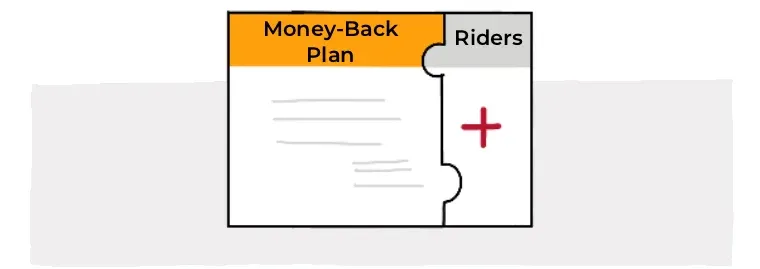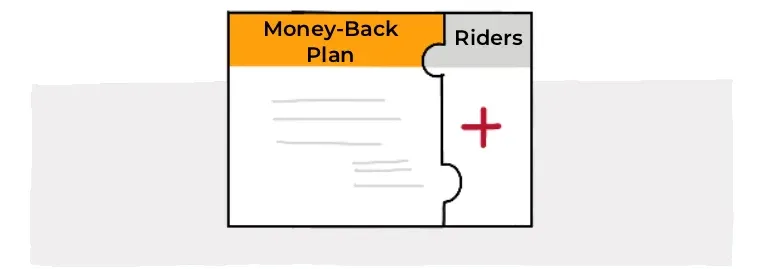While buying an electronic device, say a mobile phone, tablet, laptop, or smartwatch, you’re given a warranty of around one or two years. And, as add-ons, you also buy a protection plan, screen guard, and a cover to avoid damage of any sort - so you don’t have to worry about paying a huge price later.
Similarly, when it comes to Money-Back Insurance Plans, you can customise the policy you’ve chosen with add-on benefits known as Riders¹, at an affordable cost. They are useful tools that will help you expand your insurance coverage.
As you know, buying insurance is a huge decision and a purchase that is made for the financial security of both you and your family, no matter the situation. Hence, it is quite important that you try to plan and widen the ambit of your insurance plan to fit the unique needs and requirements of your family, to ensure that they don’t face any inconveniences in the future.
How do Riders work? What are the Riders available with a Money Back Plan? What are the pros and cons?
Let’s have a look.
How do Riders1 work?
As discussed before, riders are an add-on or extended benefit to your base money back plan. They can be purchased at an additional yet affordable cost and require no extra paperwork, which makes them a super convenient option!
They offer certain kinds of protection, if your situation falls under the conditions specified.
Riders available with Money-Back Plans
Most money back plans also provide riders as an optional add-on that may be related to medical conditions like life-threatening illnesses, personal accidents, etc.
The following riders can be purchased along with a money-back plan -
1. Surgical Care Rider
A surgical care rider offers a lump sum benefit - a fixed sum of money in case you are hospitalised for a minimum of 24 hours for a surgery that is medically necessary. The benefit amount that you’ll get under this rider will depend upon whether the surgery is classified as ‘major surgery’ or ‘other surgery’ in the policy document.
This ride comes with the following conditions -
- Only people aged 18 years and above can opt for it
- The policy term of the rider should not exceed the policy term of your base money back plan
- Waiver of Premium Rider
With a waiver of premium rider, you are allowed to enjoy the policy coverage without having to pay the future premiums - only if you meet the specified conditions.
There are two types of waiver of premium riders -
- Waiver of Premium on Critical Illness Rider
All your pending term insurance premiums will be waived off if you get diagnosed with a critical disease that is mentioned in your policy document.
- Waiver of Premium on Accidental Disability Rider
If you get disabled due to an accident, because of which you stop earning or can’t afford to pay the premiums, you won’t have to pay any of your future premiums.
3. Critical Illness Benefit Rider
If you get diagnosed with a serious disease or a medical condition, like cancer, heart disease, lung disease, etc., it could be daunting for you and your family in a mental, physical, and financial sense. It might even result in less or no income, which will make the situation even trickier.
The cost of the treatments are exorbitant and there will also be other ancillary, yet important, expenses such as nursing care, pharmacy charges, medical equipment, rehabilitation charges, etc.
A Critical Illness Rider can be an effective way to insulate your family from the financial risk of a serious illness. It will offer a fixed sum of money in case you are diagnosed with a critical illness mentioned in the policy document while your policy is in force.
Generally, there are two types of Critical Illness Riders available with insurance companies.
- Accelerated Critical Illness Rider:
An accelerated rider will simply pay you an advance amount out of your total base cover. If you use the rider for a certain amount, your base policy cover will be reduced by that amount.
- Comprehensive Critical Illness Rider:
Unlike an accelerated rider, a comprehensive rider will not affect your base policy cover amount. The cover amount of the rider is additional to the cover amount of the whole life insurance policy.
Let’s understand the difference between these two types with a simple example -
Nayan and Rekha are two individuals who have been diagnosed with cancer. Nayan has purchased a money-back plan with a cover amount of 1 crore and an accelerated critical illness rider with a cover of Rs 25 lakhs. Rekha has purchased a money-back plan with a cover amount of 1 crore along and a comprehensive critical illness rider with a cover of Rs 25 lakhs.
Now, the both of them have been advised to undergo surgery and rehabilitative care - all of which will cost them Rs 25 lakhs. Let’s have a look at how the riders they’ve chosen will work -
|
Nayan - Accidental Critical Illness Rider
|
Rakha - Comprehensive Critical Illness Rider
|
|
The insurer will pay Rs. 25 Lakhs and Nayan’s money back insurance cover will be reduced by this amount, i.e., it will be reduced to Rs. 75 Lakhs.
|
The insurer will pay Rs. 25 Lakhs for Rekha’s treatment. Using the rider won’t affect her whole life insurance cover - it will remain the same, i.e., Rs. 1 Crore.
|
Important Note - It is advisable to always opt for a Comprehensive Critical Illness Rider as it doesn’t affect your base cover amount. This keeps your insurance safety net intact while taking care of expenses associated with a listed critical illness.
4. Accidental Death Benefit Rider
This rider pays an additional sum of money to your family if you pass away due to an accident.
For example - Shaan purchases a money-back plan with a cover of Rs 1 crore along with an accidental death benefit rider with a cover of Rs 25 lakhs. He passes away due to an unfortunate accident. His family is now entitled to receive both amounts, i.e, a total sum of Rs 1.25 crores.
5.Hospital Care Rider
If you undergo hospitalisation for treatment of an illness or injury that is medically necessary, the Hospital Care Rider will pay a fixed amount of cash on a daily basis for each day you are hospitalised. To avail the benefit under this rider, you are required to be admitted to the hospital for a minimum period of 48 hours.
For example - Nikhil is diagnosed with a liver disease and is required to undergo hospitalisation for a period of 6 days. He has an active hospital care rider along with his insurance plan, which specifies that the insurer will pay Nikhil a sum of Rs 6,000 for each day that he is hospitalised. Hence, Nikhil will receive a total sum of Rs 36,000 over the span of 6 days.
Pros and cons of Riders
The pros -
- You don’t need to go through paperwork or submit any additional documents to the insurance company, except for what you have submitted for your money back plan,
- The rider is a part of the base term insurance policy, which is why you don’t need to undergo any separate medical checkups besides those you undergo at the time of taking the term insurance policy
The cons -
- As per the IRDAI (Insurance Regulatory and Development Authority of India) regulations, the premiums of a rider cannot be higher than the premium of your base term insurance policy.
- There may not be many options available to customise the rider.
- There is no significant cost difference between a rider and standalone covers available for the same situation.
A rider is a great option to expand your insurance coverage, especially if you have delayed your insurance purchase for quite a while. While they may not have as many features or benefits as standalone policies for similar conditions, they are a quick way to ensure that you keep yourself and your family extra protected and extra secure against unfortunate circumstances, without burning a hole in your wallet.





